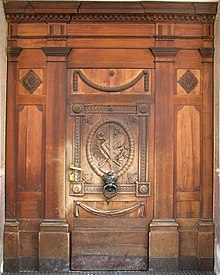Jakob Sotriffer
Jakob Sotriffer (born January 30, 1796 in Ortisei in Val Gardena ; † April 28, 1856 there ) was a South Tyrolean sculptor. He was the first teacher at the drawing school in Ortisei.
Life
Jakob became a "good carver" Sotriffer Christian d. Ä. (1751–1830) trained by Hof Ruf in Ortisei. His mother was Maria Anna Runggaldier.
1821 Emperor Franz I approved the establishment of a drawing school in Ortisei. Jakob Sotriffer was selected from four applicants and sent to Vienna for training. There he attended the academy and at the same time "the workshops of the sculptors, turners, gilders and varnishers". On his arrival in the city of Vienna in 1822, he presented the emperor with two statues made of alabaster with an Immaculata after Canova and a John the Baptist for which he received 300 guilders.
Before Sotriffer graduated from the academy, he won the 1st Gundel Prize there .
On October 15, 1824, Sotriffer finished his training and on January 25, 1825 the first drawing school in Val Gardena was opened in the Steifl house in Ortisei with great celebrations. It was not until 1832 that the Sotriffer was also allowed to teach modeling in wax, although drawing was the main subject. His son Christian (1835–1908), Johann Burgauner and finally Vinzenz Runggaldier-Janon (1839–1892) followed in class until the school was closed in 1890.
In 1928 he brokered a collection of 169 toys and small sculptures by 133 wood carvers and 33 women carvers from Val Gardena to the newly founded Tyrolean Provincial Museum Ferdinandeum .
Sotriffer was the poor fund administrator of the Ortisei community.
He married Maria Anna Prinoth on October 27, 1834.
Works
An alabaster pietà and some drawings by him are exhibited in the Val Gardena Museum. He carved the main portal of the parish church of Ortisei in Val Gardena (see picture) and angels for the parish church in Brixen.
See also
literature
- Constantin von Wurzbach : Sotriffer, Johann Jacob . In: Biographisches Lexikon des Kaiserthums Oesterreich . 36th part. Imperial and Royal Court and State Printing Office, Vienna 1878, p. 36 f. ( Digitized version ).
- Franz Moroder : The Val Gardena. 2nd Edition. Section Val Gardena of the German and Austrian Alpine Club, Ortisei in Val Gardena 1914.
- Marina Demetz: peddler trade, house industry and arts and crafts in Val Gardena. From the 18th to the beginning of the 20th century (= Tyrolean economic studies. ) Vol. 38. Wagner, Innsbruck 1987, ISBN 3-7030-0186-0 (At the same time: Innsbruck, University, dissertation, 1984).
- Christine Gruber - Ellen Hastaba: Sotriffer, Johann Jakob. In: Austrian Biographical Lexicon 1815–1950 (ÖBL). Volume 12, Verlag der Österreichischen Akademie der Wissenschaften, Vienna 2001-2005, ISBN 3-7001-3580-7 , p. 433 f. (Direct links on p. 433 , p. 434 ).
Web links
Individual evidence
- ↑ a b c d e Marina Demetz: peddler trade, house industry and applied arts in Val Gardena from the 18th to the beginning of the 20th century. 1987.
- ^ Franz Moroder: The Val Gardena. 2nd Edition. Section Val Gardena of the German and Austrian Alpine Club, Ortisei in Val Gardena 1914, p. 83.
- ^ Morgenblatt für educated readers, Volume 28, Part 2 (Bote von and für Tirol March 7, 1825)
| personal data | |
|---|---|
| SURNAME | Sotriffer, Jakob |
| BRIEF DESCRIPTION | sculptor |
| DATE OF BIRTH | January 30, 1796 |
| PLACE OF BIRTH | Ortisei in Val Gardena |
| DATE OF DEATH | April 28, 1856 |
| Place of death | Ortisei in Val Gardena |

